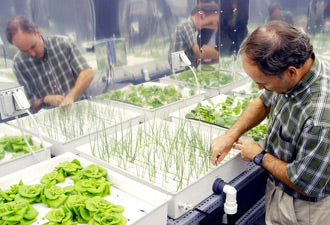
Using full spectrum lighting LEDs for plant growth

Engineers at NASA research the potential use of artificial lighting to grow food on long space missions.
Plants rely on light to produce necessary nutrients through photosynthesis. Generally speaking, sunlight is the optimal light source for plant growth. In many cases, however, sunlight is insufficient, or accelerated plant growth is desired.
Traditionally, high intensity discharge (HID) lamps have been used for plant growth. The issue with these lights is that the spectrums do not match those of what plants require, and that the efficiencies are fairly low.

A very incomplete and spiky HID lamp SPD graph.
They emit a large amount of heat, which is not detrimental to the light itself, but contributes to cooling and HVAC costs for many facilities. Furthermore, they are not RoHS compliant due to the toxicity of chemicals used.
LEDs on the other hand, allow for much flexibility in the way the spectra are constructed. Additionally, efficiencies for LEDs have reached a level such that plant growth using artificial lighting is economically feasible for both commercial and home applications.
Coupled with advances in many artificial plant growth techniques such as solution culture (liquid only) and medium culture (use of artificial soils), LED use in artificial plant growth is expanding rapidly.
The industry is currently moving towards the use of LEDs for use in vertical farming, which is expected to greatly change the way in which societies grow food.
There is much ongoing research into investigating the effect of each wavelength and its effect on plants. The findings in this field are fascinating and consequently, there has been much development in LEDs for plant growth that target specific wavelengths. At first, plant growth using artificial lighting may seem intuitively simple: grow plants as quickly as possible. However, there are many variables apart from simply growing the plants. Certain color temperatures promote flowering and fruiting (preferred for fruit plants but not for leafy vegetables), and other wavelengths promote stem growth, while other promote leaf growth.
As a manufacturer of high CRI LEDs, we have found that our LEDs serve well as an artificial light source that is truly full spectrum and a very close substitute for natural sunlight. No other LEDs come even close to being able to match the sunlight spectrum, not to mention other technologies such as HID and metal halides. Plants have relied on natural daylight for thousands of generations, so despite the ongoing research attempting to “tweak” the plant growth spectrum, providing a near-perfect daylight spectrum for plants using our high CRI LEDs is certainly a straightforward and effective approach.




Leave a comment